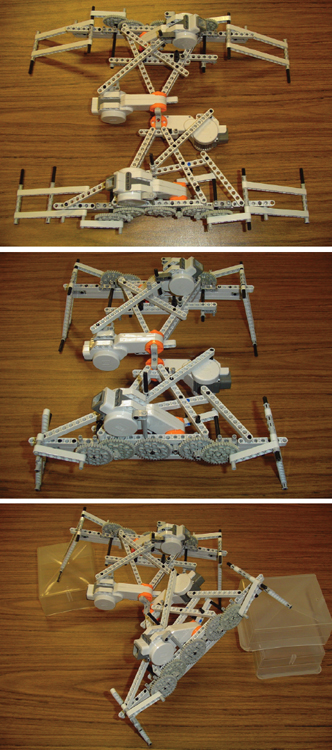Bringing Up Robots
By Fenella Saunders
Machines learn to walk faster, and better, if they figure out crawling first
Machines learn to walk faster, and better, if they figure out crawling first

DOI: 10.1511/2011.89.125
Robots can be more versatile if they have legs instead of wheels, but programming a robot to walk is no simple task. Instead of expecting the machine to pick up such complex coordination all at once, it might be easier if the goal were broken down into several simpler movements that could be learned in a series, building on each other. But how can this be done? Josh Bongard, a computer scientist at the University of Vermont, thinks one way is to have the robots themselves start out with simpler bodies that grow more complex over time.

Photographs courtesy of Josh Bongard.
As Bongard reported in the Proceedings of the National Academy of Sciences of the U.S.A., in an article published online on January 10, body shape can influence learning and behavior, even in machines. “Embodied cognition is an idea from psychology that the body plays a very important role in intelligence,” he explains. “In artificial intelligence, the focus since the 1950s has been on disembodied intelligence, trying to create ever-smarter computer programs. Robots have bodies, but that legacy of focusing on the brain or controller of the machine remains. My research focuses on demonstrating how an animal’s, or a robot’s, body helps to support intelligent behavior.”
Bongard started out with neural-network controllers—random computer codes that take input from sensors and feed it to motors. These controllers are evaluated, with the best ones recombined over many generations, until one is created that efficiently solves the task. Here, the task was navigating toward a light. The controllers were put into simulated robots, some of which started out with legs, others with legs held rigidly horizontal to the body, and the rest with no legs at all. The legless, snakelike robots would “grow” legs during their “lifetimes” in the simulation. The robots with horizontal legs would have them become more vertical during the trials. Some of the robots would also evolve over generations. For example, later-generation snakelike robots would stay legless for shorter periods of their lifetimes.
After evolving many populations of robots, Bongard’s algorithm found controllers most quickly for the final legged form if he combined body change within the robots’ own lifetimes with change over evolutionary time. Snakelike robots first would learn to propel themselves by moving their spines, and then once legs were added, they only needed to learn to balance. The changing body shape essentially allowed them to break the difficult problem of walking into two smaller pieces, which they could tackle separately—a bit like adding training wheels, says Bongard. They were able to learn to walk toward a light in minutes, as compared with hours for robots that started out with legs. The leg-growing robots also were better able to handle varied and difficult terrains, because they had already dealt with so many different perturbations as they morphed through changing body types.
As a final trial, Bongard implemented a similar control system on real robots with legs that were initially held horizontal and gradually descended during the test. He used both quadruped and hexapod robots to make sure the model is not specific to any particular body plan. Like the simulations, Bongard found that the physical robots learned to walk faster and could deal with uneven terrain. He is now working on a robot that will “grow” legs while it learns, perhaps using some kind of telescoping mechanism. He thinks the theory could be useful particularly in modular robotics, where the devices are made up of a bunch of small segments that can attach together in many different ways, and could actually reconfigure from snakes to legged machines or other shapes.
“We need to think about robots that change shape, very much like animals and humans change their bodies as they grow and learn,” Bongard says. “There’s a real engineering advantage to that—it’s not just something extra that biology does. It serves a practical purpose.”
Indeed, this concept from robotics might feed back into biological research. “Body-plan changes seem like something nature had to do because it had no other choice, but this suggests that actually natural selection may select for body-plan change because it supports learning,” Bongard says. “Robotics can never really answer questions in biology, but it definitely can generate hypotheses that biologists might never have thought of otherwise.”
Click "American Scientist" to access home page
American Scientist Comments and Discussion
To discuss our articles or comment on them, please share them and tag American Scientist on social media platforms. Here are links to our profiles on Twitter, Facebook, and LinkedIn.
If we re-share your post, we will moderate comments/discussion following our comments policy.